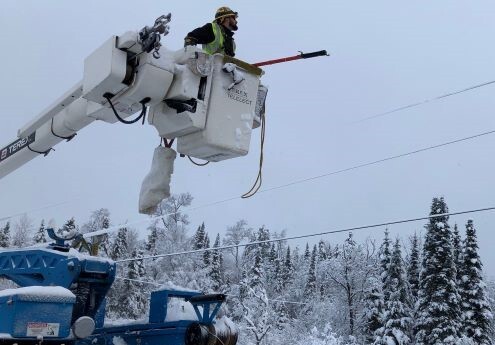VEC Reliability and Resiliency

In January, winter storms Finn and Gerri brought significant damage to Vermont, taking down trees, power poles/lines and blowing away roofs. This comes after six months of intense, devastating weather including historic flooding in July and four rounds of wet heavy snow in December. We are so thankful for our resilient and patient members as we worked to restore power as safely and quickly as possible after each incident.
Climate change has brought more frequent, damaging inclement weather, and we know our members rely on power for comfort, light, heat, connectivity and increasingly transportation. Our mission has been reliability since our start in the 1930s. Now that mission is more important than ever and also more challenging to deliver on. Here is how we’re working to deliver on our commitment to reliability today and into the future.
Strong Resilient Infrastructure: Improving Reliability
Our 2,400-plus miles of line serving over 40,000 locations requires ongoing proactive maintenance and improvement. We continue to invest more to meet the needs of our quickly evolving future.
Vegetation management. While they are beautiful, trees are the biggest contributor to outages when weather hits. We spend millions annually to trim trees in our rights-of-way and find ways to do that ever-more efficiently. This continues to be a foundational strategy to maintain reliability.
Hardening the grid. This involves moving lines out of the woods, closer to roads to increase speed of repairs, burying lines where feasible and adding more durable “tree wire” or using close-arm construction in cases where going underground is not feasible. The less exposure that we have to trees or weather, the more resilient the lines become and the lower cost to maintain over the years.
Increasing redundancy. Automated sensors and switches in the field allow us to quickly identify faults, then re-route power from another source when possible. We continue to add automated redundancy that can reduce the number of members impacted by an outage.
Battery storage. In certain scenarios, batteries can provide resiliency, particularly when paired with on-site generation like solar. It's still expensive, yet we are embracing early opportunities and expect more to come. A microgrid we’ve co-developed with Craftsbury Outdoor Center and the offer of incentives for homeowners to install battery backup are two examples of this increasingly important strategy.
When the Power goes Out: Faster Restoration
When the lights do go out, our team jumps to respond. While the blue trucks and field workers are the most visible part of our storm operation, it takes a huge team of people including many behind the scenes taking calls, dispatching crews, communicating with members, and supporting software systems and logistics. We are always working to restore power faster using some of the following strategies.
State-of-the-art technology. These digital systems help us efficiently deploy crews by understanding the electric connectivity and tracking hundreds of issues for resolution. The more efficient we can be with our organization, the faster we can get the right crews to the right spot and start working on restoration. In January we had hundreds of outages impacting over 20,000 people. Some of those outages had multiple issues to be fixed, especially broken poles and downed wire.
Storm roles. All VEC employees have a role when storms hit. We spend hours training and planning before the winter and prior to each predicted storm, so giving which surprised us all on a Sunday afternoon, and during Finn and Gerri when we had six long intense days of restoration.
Mutual Aid from neighbor utilities. During storms help from other utilities makes our whole region stronger. Just before Christmas, two VEC crews helped restoration at another Cooperative in northern Maine. In Finn and Gerri, VEC had more than triple our usual crews on the system with support from a dozen different utilities in Vermont and Massachusetts.
Redefining What’s Possible: Exploring New Technologies
We also spend a lot of time figuring out how technology can help us do things more safely or cost-effectively from construction to restoration.
Underground cable-in-conduit. Currently underground installation requires digging an open trench, laying conduit, and then pulling electric cable through the conduit. Emerging technology bonds the cable and the conduit together and uses boring technology to install the line without a trench. This approach has downsides but also the potential to be faster and cost-effective - an exciting possibility we are exploring.
Drones for inspection and restoration. We’ve been successfully experimenting with using drones for proactive line inspections – catching issues before they cause damage. We also plan to try drones for restoration activity, helping field crews identify issues to expedite a critical part of the restoration work.
Finally, to our members: thank you for all you do for your communities, for your kind words during times when we are restoring power, and as always please be in touch with any questions or comments.